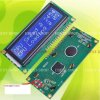MrDEB
Well-Known Member
Junebug w/LCD/SF
Having issues w/ LCD won't display Tried two different PICs as well as two different LCds
All I get are the little squares.
Checked and rechecked all wiring
Planning on hooking up a Junebug directly to the LCD but only have A.1-A.4 available and Swordfish won't allow .
Only a 0 or a 4 are allowed not a 1
Something really wrong. Am thinking maybe the Junebug is not operating correctly?
Can get an LED to blink.
going bananas in Idaho
about ready to try a third LCD
Having issues w/ LCD won't display Tried two different PICs as well as two different LCds
All I get are the little squares.
Checked and rechecked all wiring
Planning on hooking up a Junebug directly to the LCD but only have A.1-A.4 available and Swordfish won't allow .
Only a 0 or a 4 are allowed not a 1
Something really wrong. Am thinking maybe the Junebug is not operating correctly?
Can get an LED to blink.
going bananas in Idaho
about ready to try a third LCD


